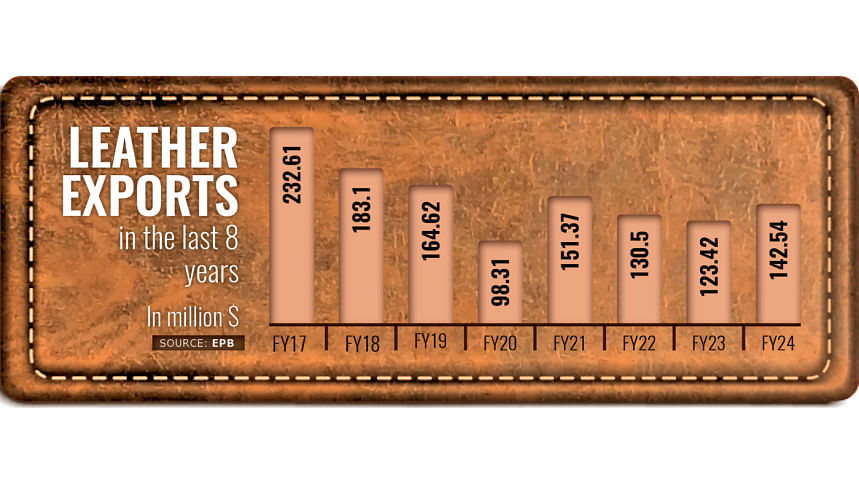Leather exports drop 64% in 10 years as CETP woes linger

The country's leather exports have plunged by over 64 percent in the past decade, due mainly to the failure to complete the Central Effluent Treatment Plant (CETP) at the Savar Tannery Estate -- a key requirement for obtaining international environmental certifications.
In the fiscal year (FY) 2014, the country exported leather worth $397 million. By FY2024, that figure had fallen to just $142.54 million.
Leather exporters described the stalled CETP as the single biggest hurdle to achieving Leather Working Group (LWG) certification, the globally recognised benchmark for environmental compliance in production.
Without LWG certification, Bangladeshi leather remains locked out of premium international markets, said Syed Nasim Manzur, president of the Leathergoods and Footwear Manufacturers & Exporters Association of Bangladesh (LFMEAB).
Leather exporters described the stalled CETP as the single biggest hurdle to achieving Leather Working Group (LWG) certification, the globally recognised benchmark for environmental compliance in production
"Without LWG certification, we are invisible to major global buyers who demand verifiable sustainable sourcing" said the association president at an event organised by the Dhaka Chamber of Commerce and Industry (DCCI) in the capital yesterday.
Following years of resistance, tanneries were relocated from Hazaribagh area in Dhaka to the capital's outskirts Savar in 2017.
The move was meant to improve environmental standards, but the CETP still remains incomplete and largely non-functional.
Unable to meet the strict compliance demands of leading global brands, Bangladesh consequently sells leather at cut-price rates to Chinese intermediaries.
LFMEAB President Manzur urged the government to take immediate action, including appointing an internationally accredited operator for the CETP, offering green financing, and extending the same policy support enjoyed by the readymade garment sector.
That includes bonded warehouse facilities and duty-free imports of machinery. Manzur said that a fully functioning CETP could potentially double leather exports.
As international markets increasingly prioritise sustainability, he called for rapid reforms to establish Bangladesh as a responsible producer.
"The local leather sector can thrive in the post-LDC era," Manzur added, "but only if we deliver on compliance, starting with a fully operational, LWG-ready CETP."
Speaking at a separate focus group on post-LDC export strategies, Adilur Rahman Khan, adviser to the Ministry of Industries, echoed this urgency.
With Bangladesh set to graduate from least developed country (LDC) status by 2026, the adviser said the country must prepare fast.
Despite earning around $1.2 billion annually from leather, leather goods and footwear, Bangladesh accesses only a sliver of the $420 billion global leather market, Khan added.
"Achieving the government's $12 billion export target by 2030 will require bold reforms, international certification and a modernised value chain," he said.
Md Saiful Islam, chairman of the Bangladesh Small and Cottage Industries Corporation (BSCIC), said that the Savar CETP can currently treat only 14,000 cubic metres of effluent daily.
It is well below the 32,000 to 35,000 cubic metres required during the peak season after Eid-ul-Azha, the second largest festival for Muslims involving the ritual of sacrificing animals.
Islam said six individual Effluent Treatment Plants (ETPs) have been approved, two of which are nearing completion. Another 8 to 10 are in the pipeline, expected to add an extra 8,000 to 10,000 cubic metres of capacity.
According to the BSCIC chairman, a technical committee has been tasked with upgrading the CETP's capacity to 25,000–26,000 cubic metres, with long-term plans to reach 40,000. This effort is backed by a European Union-supported project.
Md Hafizur Rahman, administrator of the Federation of Bangladesh Chambers of Commerce and Industry (FBCCI), said the leather sector is struggling to attract foreign investment and buyers because of its lack of certification.
He said it was unclear how quickly these challenges could be resolved, but stressed that the issues surrounding the CETP must be addressed without further delay.
Nazneen Kawshar Chowdhury, additional secretary of the WTO wing at the Ministry of Commerce, said the post-LDC era would come with significant challenges, but also with opportunities.
She urged the private sector to prioritise compliance with environmental and labour standards and said the government was open to collaboration in enhancing the CETP's capacity.
Md Ariful Haque, director general of the Bangladesh Investment Development Authority (Bida), said the country's economy has the potential to double in size over the next 15 years, but achieving this will require close coordination between public and private sectors.
To support local businesses and spur growth, Haque said Bida is stepping beyond conventional approaches and directly engaging with foreign investors, which he believes will bring promising results.
The event was moderated by DCCI President Taskeen Ahmed. It was also addressed by Md Nurul Islam, CEO of the Bangladesh Tanners Association (BTA); Ibnul Wara, managing director of Austan Ltd; Md Nasir Khan, managing director of Jennys Shoes Ltd; Ziaur Rahman, managing director of Bay Group; and M Abu Hurairah, former vice-president of DCCI.

 For all latest news, follow The Daily Star's Google News channel.
For all latest news, follow The Daily Star's Google News channel. 



Comments